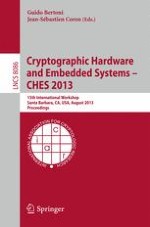2013 | Buch
Cryptographic Hardware and Embedded Systems - CHES 2013
15th International Workshop, Santa Barbara, CA, USA, August 20-23, 2013. Proceedings
herausgegeben von: Guido Bertoni, Jean-Sébastien Coron
Verlag: Springer Berlin Heidelberg
Buchreihe : Lecture Notes in Computer Science
